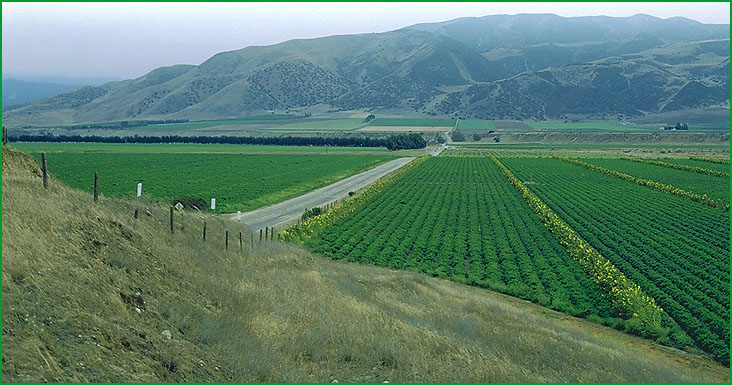 | Subsection h - Salinas Valley |
near Greenfield Ś Robert Ettner |
http://www.fs.fed.us/r5/projects/ecoregions/261ah.htm
This subsection is on an alluvial plain on the east side of Monterey Bay and the alluvial plain of the Salinas Valley. The climate is modified greatly by marine influence. MLRAs 14d and 14e.
Lithology and Stratigraphy. Pleistocene, and some Plio-Pleistocene, nonmarine deposits and recent alluvium are predominant in this subsection. There is a relatively small area of Quaternary marine deposits on the north side of Monterey Bay, and dune sand around the bay that is fairly extensive on the southeast side of the bay.
Geomorphology. The alluvial plains are mostly gently sloping to nearly level floodplain, stream terraces, and alluvial fans in the Salinas Valley, and also dissected Quaternary nonmarine deposits on the Watsonville Plain. Quaternary marine terraces are present around Capitola. There are recent dunes along the west side of Monterey Bay and stabilized dunes on the southeast side of the bay. The subsection elevation range is from sea-level up to about 1000 feet on alluvial fans in the Salinas Valley. Fluvial erosion and deposition are the main geomorphic processes. Wind is an active geomorphic agent along the west side of Monterey Bay.
Soils. The soils are mostly Fluventic, Fluvaquentic, and Pachic Haploxerolls and Typic and Chromic Pelloxererts on floodplains. They are Entic, Typic, and Pachic Haploxerolls, Ultic Palexerolls, and Typic Natrixeralfs on stream terraces and old alluvial fans. Xeric Argialbolls, Pachic Argixerolls, and Mollic Palexeralfs are the main soils on marine terraces. Alfic Xeropsamments and Psammentic Haploxeralfs are the main soils on stabilized dunes. Most, but not all, of the soils are leached free of carbonates. Soluble salts accumulate in some soils that are near the ocean. The soils are mostly well drained, but some on floodplains are poorly drained. Soil temperature regimes are mostly thermic (nearly mesic), and some isomesic near the ocean. Soil moisture regimes are mostly xeric (nearly ustic), but some are aquic on floodplains.
Vegetation. The predominant natural plant communities are Valley oak series and Needlegrass grasslands in the Salinas Valley and Coast live oak series and California oatgrass series on the Watsonville Plain. There are Cottonwood woodlands in riparian areas along the Salinas River. The dunes support a succession of plant communities, from bare dune through herbaceous communities and Coyote brush series to California sagebrush - black sage series on stabilized dunes on the southeast side of Monterey Bay. There is some Pickleweed series in estuaries.
Characteristic series by lifeform include:
Dune vegetation: Dune lupine - goldenbrush series, Native dunegrass series, Sand-verbena - beach bursage series, Yellow bush lupine series.
Saltmarsh vegetation: Cordgrass series, Ditchgrass series, Pickleweed series, Saltgrass series, Sedge series.
Grasslands: California annual grassland series, California oatgrass series, Pacific reedgrass series, Purple needlegrass series.
Shrublands: Blue blossom series, California sagebrush series, California sagebrush - black sage series, Woollyleaf manzanita series.
Forests and woodlands: Coast live oak series, Fremont cottonwood series, Mixed willow series, Valley oak series.
Climate. The mean annual precipitation is about 12 inches in the Salinas Valley up to about 30 inches on the northeast side of Monterey Bay. It is practically all rain. Summer fog is common. Mean annual temperature is about 56░ to 58░ F. The mean freeze-free period is about 250 to 300 days.
Surface Water. Runoff is slow across the alluvial plains. All but the larger streams are dry through most of the summer. Natural lakes are absent, although there is temporary ponding behind sand dunes.
